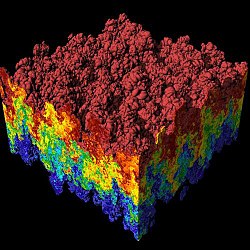偏微分方程式の数値解法
| 微分方程式 |
|---|
 |
| 分類 |
| 解 |
| 計算物理学 |
|---|
 |
数値解析 · シミュレーション |
偏微分方程式の数値解法 (へんびぶんほうていしきのすうちかいほう、英: Numerical methods for PDEs) は、数値解析において偏微分方程式を数値的に解く技術の総称である。
背景
数値解法の必要性
これまで様々な自然現象 (物理現象など) を記述するために多くの偏微分方程式が作られ、多くの数学者たちがその解法を探求してきたが、ソリトン方程式に対する広田の方法やen:inverse scattering transform などを除いて、偏微分方程式を手計算だけで厳密に解く技術はほとんどないに等しい。そのため多くの研究者たちが偏微分方程式を数値的に解く技術について研究をしてきた。
差分法とその問題点
偏微分方程式を数値的に解く技術の中で最も初歩的なものは差分法である。これは微分を差分で近似して解くというものである。
この方法で精度良く解けるということは少なからずあるが、万能な解法ではない。例えば
などは非線形性によって差分法では精度の良い計算ができず、数値実験結果だけを見ていると間違った結論 (幻影解) にたどり着く危険がある。そのため、有限要素法・有限体積法などのように差分法以外の方法が追求されると同時に、よりよい差分化を模索する動きが始まった。
差分法の進化
ここで言う「よりよい差分化」とは、元の方程式が持つ何らかの性質を保存した差分化のことである。着目する性質によって流派が異なる。
可積分差分スキーム
広田良吾やAblowitzたちは可積分性 (英: Integrability, 可積分系で最も重要視される性質) を保存する差分化スキームを開発した。これは今日では可積分差分スキームとして知られており、差分法などの標準的手法と比べて精度がよくなることもわかっている。差分間隔を自動で調整する可積分差分スキームも開発されている。
構造保存型数値解法
一方で、多くの偏微分方程式は物理現象に由来しているので、保存則・散逸則など何らかの物理的性質を保存した差分化も考えられる。このような差分解法は構造保存型数値解法 (英: Structure Preserving Numerical Methods) と総称される。代表的なものとして、
- シンプレティック数値解法
- 離散勾配法
- 離散変分法
- 離散変分導関数法
などがある。数値線形代数との関連も研究されている。
汎用解法
可積分差分スキーム・構造保存型数値解法は高精度な解法だが、与えられた方程式の性質に依存するため、汎用性が低いという弱点がある。そのため現代でも、可積分差分スキーム・構造保存型数値解法の研究と並行して、高精度で汎用性のある差分法が研究されている。例えば、
- Shortley-Weller 近似
- Swarztrauber-Sweet 近似
- Ascher-Mattheij-Russell 差分公式
等がある。
解の存在検証
ここまで高精度に解く技術について説明したが、それと並行して「計算機で解の存在を検証する」という研究もおこなわれている。このような研究が必要となるのは、近似解が求まったとしてもそれが幻影解である危険性があるからである。実際、すでに幻影解は報告されている。解の存在検証に関する研究は活発に行われており、2012年度日本数学会秋季賞や2011年度���本応用数理学会論文賞を受賞している。
固有値評価
解の一意存在性検証など、偏微分方程式に関連する多くの問題は微分作用素の固有値評価と密接に関係している。そのため、偏微分方程式の近似解法・誤差評価の研究と並行して、固有値問題の近似解法・誤差評価について様々な研究がなされている。
関連する関数解析学の概念
関連ライブラリ・ソフトウェア
- VCP C++で作成されたライブラリで, BLAS・LAPACKによる高速化が可能である
- en:Chebfun
有限要素法
- FreeFem++
- en:FEniCS Project
- FEniCS - GitHub
- FEniCS Project (@fenicsproject) - X(旧Twitter)
- femhub - GitHub
- FEMhub (@femhubsocial) - X(旧Twitter)
- FEMhub (@femhubsocial) - Instagram
これまで解の存在検証・計算機援用証明が行われた方程式
- ポアソン方程式
- アレン・カーン方程式
- ナビエ・ストークス方程式
- en:Kuramoto–Sivashinsky equation
- en:Orr–Sommerfeld equation
- バーガース方程式
- 熱方程式
- 移流方程式 (en)
主な研究者
日本
海外
- イズライル・ゲルファント (差分解法を開発)
- ピーター・ラックス (ラックス・フリードリヒ法、ラックス・ウェンドロフ法で知られる)
- ジョン・フォン・ノイマン (ノイマン・ディリクレ法、ノイマン・ノイマン法で知られる)
- ペーター・ドイフルハード (論文・著書を多数執筆)
出典
離散化・近似解法に関する論文
精度保証・計算機援用証明に関する論文
参考文献
和書
- 菊池文雄、斎藤宜一:数値解析の原理、岩波書店 (2016年).
- 山本哲朗:「境界値問題と行列解析」、朝倉書店(朝倉数学大系 7)、(2014年11月)。
- 田端正久:「偏微分方程式の数値解析」、岩波書店 、ISBN 978-4-00-005979-4 (2010年).
- 三井斌友 et. al.:「微分方程式による計算科学入門」、共立出版(2004年)。
- 神谷紀生、北栄輔:「偏微分方程式の数値解法」、共立出版(工系数学講座 11)、ISBN 978-4-320-01610-1, (1998年)。
- S. J. Farlow(著)、伊理正夫・伊理由美(訳):「偏微分方程式:科学者・技術者のための使い方と解き方」, 朝倉書店、ISBN 978-4-254-11071-5(1996年12月)。
- 登坂宣好、大西和榮:「偏微分方程式の数値シミュレーション」、東京大学出版会(2003年)。
- 山崎郭滋(著) :「偏微分方程式の数値解法入門」、森北出版 (1993年).
有限要素法
境界要素法
- J. T. カチカデーリス(著)、田中正隆、荒井雄理(訳):「境界要素法:基本と応用」、朝倉書店、ISBN 978-4-254-23104-5、(2004年10月)。
スペクトル法
洋書
- Iserles, A. (2009). A first course in the numerical analysis of differential equations. Cambridge University Press.
- Computational Partial Differential Equations Using MATLAB, Jichun Li and Yi-Tung Chen, en:Chapman & Hall.
- Ames, W. F. (2014). Numerical methods for partial differential equations. Academic Press.
有限要素法
- Brenner, S., & Scott, R. (2007). The mathematical theory of finite element methods. Springer Science & Business Media.
- Johnson, C. (2012). Numerical solution of partial differential equations by the finite element method. Courier Corporation.
- Strang, G., & Fix, G. J. (1973). An analysis of the finite element method. Englewood Cliffs, NJ: Prentice-hall.
- Boffi, D., Brezzi, F., & Fortin, M. (2013). Mixed finite element methods and applications. Heidelberg: Springer.
- Braess, D. (2007). Finite elements: Theory, fast solvers, and applications in solid mechanics. Cambridge University Press.
有限差分法
- Smith, G. D. (1985). Numerical solution of partial differential equations: finite difference methods. Oxford University Press.
- Strikwerda, J. C. (2004). Finite difference schemes and partial differential equations. SIAM.
有限体積法
- Eymard, R. Gallouët, T. R. Herbin, R. (2000) The finite volume method, in Handbook of Numerical Analysis, Vol. VII, 2000, p. 713–1020. Editors: P.G. Ciarlet and J.L. Lions.
- LeVeque, Randall (2002), Finite Volume Methods for Hyperbolic Problems, Cambridge University Press.
境界要素法
- Banerjee, Prasanta Kumar (1994), The Boundary Element Methods in Engineering (2nd ed.), London, etc.: en:McGraw-Hill,ISBN 978-0-07-707769-3.
- Beer, Gernot; Smith, Ian; Duenser, Christian, The Boundary Element Method with Programming: For Engineers and Scientists, Berlin – Heidelberg – New York: Springer-Verlag, pp. XIV+494,ISBN 978-3-211-71574-1
- Cheng, Alexander H.-D.; Cheng, Daisy T. (2005), "Heritage and early history of the boundary element method", Engineering Analysis with Boundary Elements, 29 (3): 268–302.
- Katsikadelis, John T. (2002), Boundary Elements Theory and Applications, Amsterdam: Elsevier, pp. XIV+336,ISBN 978-0-080-44107-8.
- Wrobel, L. C.; Aliabadi, M. H. (2002), The Boundary Element Method, New York: John Wiley & Sons, p. 1066,ISBN 978-0-470-84139-6 (in two volumes).
スペクトル法
- Lloyd N. Trefethen (2000) Spectral Methods in MATLAB. SIAM, Philadelphia, PA.
- D. Gottlieb and S. Orzag (1977) "Numerical Analysis of Spectral Methods : Theory and Applications", SIAM, Philadelphia, PA.
- J. Hesthaven, S. Gottlieb and D. Gottlieb (2007) "Spectral methods for time-dependent problems", Cambridge UP, Cambridge, UK.
- Canuto C., Hussaini M. Y., Quarteroni A., and Zang T.A. (2006) Spectral Methods. Fundamentals in Single Domains. Springer-Verlag, Berlin Heidelberg
構造保存型数値解法
- Leimkuhler, B. and Reich, S., Simulating Hamiltonian Dynamics, Cambridge University Press, Cambridge, 2004.
- Sanz‐Serna, J. M. and Calvo, M. P., Numerical Hamiltonian Problems, Applied Mathematics and Mathematical Computation 7, Chapman & Hall, London, 1994.
- Arnold, D. N., Bochev, P. B., Lehoucq, R. B., Nicolaides, R. A. and Shashkov, M. (eds.), Compatible Spatial Discretizations, in The IMA Volumes in Mathematics and Its Applications, Springer, New York, 2006.
- Budd, C. and Piggott, M. D., Geometric integration and its applications, in Handbook of Numerical Analysis, XI, North‐Holland, Amsterdam, 2003, 35‐139.
- Christiansen, S. H., Munthe‐Kaas, H. Z. and Owren, B., Topics in structure‐preserving discretization, en:Acta Numerica, 20 (2011), 1‐119.
- Shashkov, M., Conservative Finite‐Difference Methods on General Grids, en:CRC Press, Boca Raton, 1996.
- Jan S. Hesthaven: "Numerical Methods for Conservation Laws: From Analysis to Algorithms", SIAM, ISBN 978-1-611975-09-3 (2018).
外部リンク
- Probabilistic-Numerics.org、確率論を取り入れた偏微分方程式の数値解法 (英: Probabilistic Integrator) に関する情報をまとめたサイト
解説記事
- 楕円型連立半線形偏微分方程式の解に対する精度保証付き数値計算法 (PDF)
- 偏微分方程式の精度保証付き数値計算法:半線形楕円型境界値問題 (PDF)
- Introduction to Numerical Analysis for Partial Differential Equations (PDF)
- (偏微分方程式の) 数値計算の落とし穴 (PDF)
研究グループ
- Numerical Analysis Group at the Graduate School of Mathematical Sciences, The University of Tokyo (東京大学大学院数理科学研究科内にある非線形偏微分方程式の数値解法に関する研究グループ)
- 数値情報学研究室(数理情報第3研究室) (東京大学工学部計数工学科内にある非線形偏微分方程式の数値解法に関する研究グループ、杉原正顯がかつて教授を務めていた)
- 科学技術計算と数値解析 (日本応用数理学会の研究部会)
精度保証付き数値計算
- 精度保証付き数値計算の研究及びその偏微分方程式への応用、2012年度日本数学会秋季賞
- 精度保証付き数値計算と水面波方程式、一橋大学ウェブマガジン (2015年1月)
- 偏微分方程式の解に対する精度保証付き数値計算法の発展
- 非線形放物型方程式に対する解の精度保証付き数値計算理論の研究
- 双曲型偏微分方程式に対する解の精度保証付き数値計算理論の研究
- 有限要素法に基づく精度保証付き数値計算の高度化に関する研究
